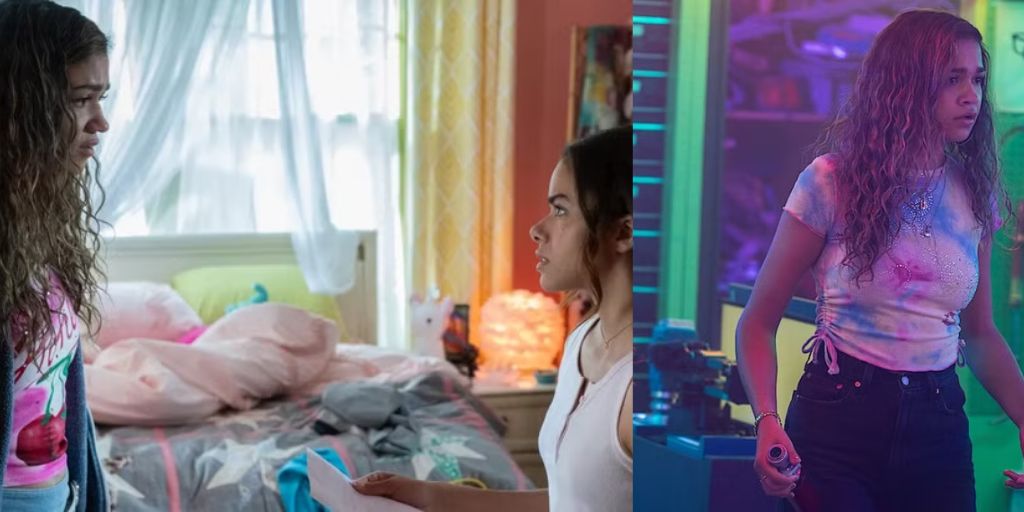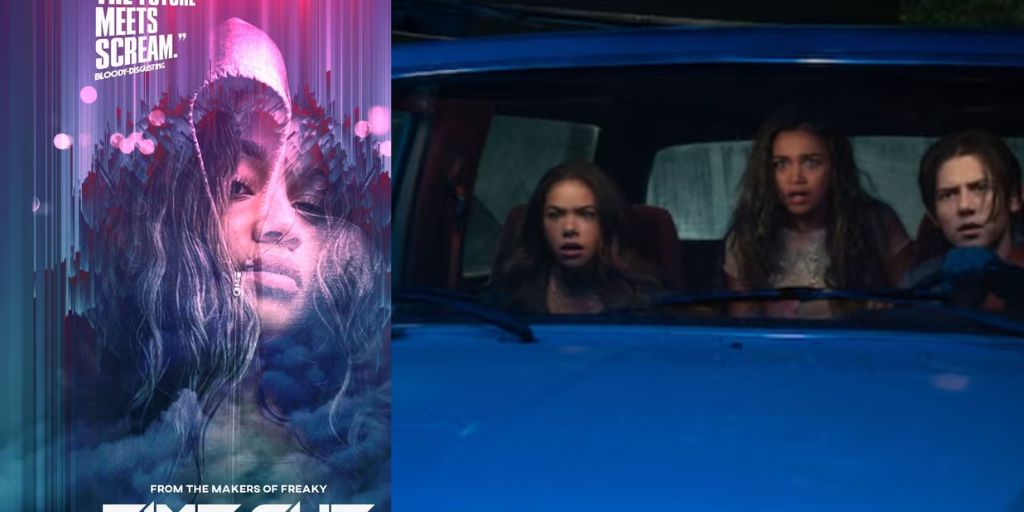Netflix’s latest release, Time Cut, is a film that mixes horror, time travel, and heartfelt family moments, but it has drawn some comparisons to Prime Video’s Totally Killer.
Last year’s Totally Killer follows a young woman (played by Kiernan Shipka) who time-travels to the 1980s to prevent a masked killer from targeting her mom’s friends.
Similarly, Time Cut centers around Madison Bailey (from Outer Banks) in the role of Lucy, who also travels back in time to prevent a tragic event in her family’s past. The two films have some similarities, both using time-travel to add excitement and suspense to the storyline.
However, while Totally Killer leans into the horror, Time Cut focuses more on family and the emotional connection between two sisters.
The origins of Time Cut set it apart, as the movie was filmed during the COVID-19 pandemic, facing delays before its release this year.
Directed by Hannah MacPherson, the film goes beyond the typical horror approach, instead diving into the story of two siblings who connect across time.
While Time Cut is indeed a slasher film, it has a strong emotional core that places family ties front and center, with horror elements becoming secondary.
This combination makes it unique among recent horror releases, as it delivers moments of fear while also offering heartwarming interactions between the two main characters.
The plot centers on Lucy Field, a young and talented scientist excited to pursue a career in space exploration. Her dream takes a huge leap forward when she’s offered an internship at NASA. This opportunity is everything she has worked for, and Lucy is overjoyed.
However, when she shares the news with her parents, she is met with an unexpected reaction—they look worried rather than excited. Instead of supporting her, her parents start listing reasons why they’d rather have her stay home.
Their reaction is influenced by an event that changed their lives forever: the tragic death of their oldest daughter, Summer, in 2003. Summer’s murder at the hands of a masked killer left scars that still affect how her parents view the world, and the grief they carry now affects Lucy’s life.
This sense of loss and lingering grief sets up the movie’s main storyline. On the anniversary of her sister’s death, Lucy visits Summer’s grave.
While she’s there, she discovers a strange machine that turns out to be a time-travel device, accidentally sending her back to 2003, days before Summer’s tragic death. Lucy finds herself in her hometown, where she encounters her sister alive and well.
This time-travel accident gives Lucy the unique chance to meet and spend time with her sister—a person she’s only ever known through family stories and photographs.
At first, she’s simply excited to be with Summer, but soon her determination grows. She is set on preventing her sister’s death, even though changing the past could have major effects on her own existence.
Lucy knows that if she succeeds in saving Summer, her own life might be at risk, as her parents may never have had a second child if they hadn’t lost their first. This twist adds complexity to Lucy’s mission, making her journey both heartwarming and risky.
While Time Cut involves horror, the film is surprisingly tender and focuses on the bond between Lucy and Summer.
Madison Bailey and Antonia Gentry, who plays Summer, share an on-screen connection that makes their sibling bond believable and relatable. Their interactions are heartfelt, showing Lucy and Summer as sisters who truly care for one another, even though they are just meeting.
For example, one scene captures a lighthearted moment when Lucy tries on Summer’s clothes in her bedroom, putting on heart-shaped sunglasses and low-rise jeans—a popular style in the early 2000s.
This makeover scene serves as a warm, nostalgic nod to classic early 2000s films, where such sequences were common and celebrated, highlighting Lucy and Summer’s growing connection.
The film’s dedication to recreating the early 2000s is apparent in nearly every scene. The costumes, music, and set designs pull viewers back to 2003, complete with the fashion trends of that time.
Lucy, now in her sister’s world, walks through a high school filled with students wearing Juicy Couture tracksuits, colorful hair clips, and tennis shoes with squeaky wheels.
One memorable scene features Lucy spotting Summer in the school hallway while Hilary Duff’s song “So Yesterday” plays in the background. This is a joyful moment for fans of early 2000s pop culture, bringing back memories of an era marked by flip phones, specific fashion trends, and the carefree spirit of the time.
For those who grew up in that period, the movie’s accurate portrayal of the early 2000s captures a wave of nostalgia, creating a comforting, familiar setting.
Although the movie brings a sense of nostalgia and family warmth, Time Cut is still, at its core, a slasher film. Lucy realizes she’s returned to a time when a killer is on the loose, targeting a group of four students, including her sister.
Determined to save them, Lucy teams up with a school outcast, played by Griffin Gluck, to try and prevent the murders. Yet, even with this horror element, the film doesn’t emphasize the intense gore or suspense typical of the slasher genre.
Viewers expecting a more traditional horror experience might be surprised that the film leans away from intense scare scenes and focuses more on the characters’ emotional journeys.
This approach to horror is especially notable given the involvement of Michael Kennedy, known for his work on horror-comedy films like Freaky and It’s A Wonderful Knife.
Time Cut has a few intense moments, like a dramatic mall scene, but it avoids the typical horror staples of high-pitched screams, fast-paced chases, or startling twists.

Instead, it opts for a milder, more character-driven take on horror, using suspense sparingly. The horror in Time Cut is present but is not the central feature of the film; instead, it complements the main focus on Lucy’s journey and her connection with Summer.
For viewers hoping for a full-on horror experience, this toned-down approach might feel lacking. However, Time Cut sets itself apart by prioritizing the emotional storyline over typical horror. The film explores how grief, love, and the desire to protect family can cross the boundaries of time.
This makes the movie feel more relatable and adds an emotional depth that’s uncommon in slasher films. The few frightening moments add tension, but they’re not the main focus, allowing viewers to see the characters’ relationships as central to the plot.
The heart of Time Cut lies in the idea that family connections can overcome fear, and this theme drives the story more than any horror aspect.
Time Cut is best seen as a time-travel tale with a heartwarming twist, rather than a straightforward slasher film. Its unique combination of horror and family makes it different from most films in the genre.
By blending early 2000s nostalgia with themes of love and sacrifice, Time Cut captures a feeling of warmth and connection rarely seen in horror movies.
The sibling bond between Lucy and Summer creates a storyline that goes beyond scares, leaving viewers with a story of hope, family, and second chances.
Time Cut won’t deliver intense horror, but for viewers who want a lighter, sentimental experience, it could be a great choice. It offers a warm, cozy look at early 2000s culture, reminding us of the fashion, music, and energy of the time.
Although it doesn’t fully deliver on gore, it gives a refreshing take on the slasher genre, inviting viewers to see horror through a softer lens. This makes Time Cut a unique Halloween choice, providing a comforting movie night experience filled with nostalgia and family moments.
Time Cut stands out as a unique take on the horror genre, blending nostalgia, family bonds, and time travel into a story that defies typical slasher conventions.

While many horror films rely heavily on gore and suspense to capture viewers’ attention, Time Cut takes a different path by focusing on the heartwarming relationship between Lucy and Summer, two sisters separated by tragedy but reunited by a twist of fate.
Their bond brings a fresh perspective to the genre, as the film ultimately conveys a message of family love and the lengths one would go to protect loved ones, even if it risks altering their own existence.
The film’s nostalgic early-2000s setting further enhances its charm, providing viewers with a comforting trip back in time through music, fashion, and cultural references.
This thoughtful recreation of the era adds another layer to Lucy’s journey, creating a sense of warmth that contrasts with the horror elements.
Although Time Cut may not satisfy die-hard fans of intense horror, it successfully appeals to those looking for a lighter, more heartfelt experience within the genre. For Halloween or any movie night, Time Cut offers something different: a blend of nostalgia, sentiment, and suspense.
By balancing horror with heart, Time Cut delivers a film that is as touching as it is thrilling, making it a standout choice for anyone seeking a fresh approach to supernatural suspense.













